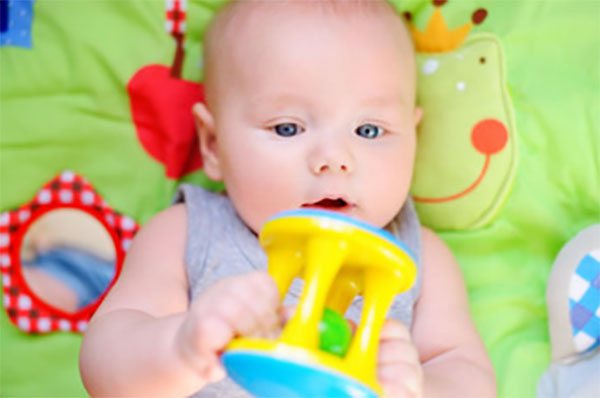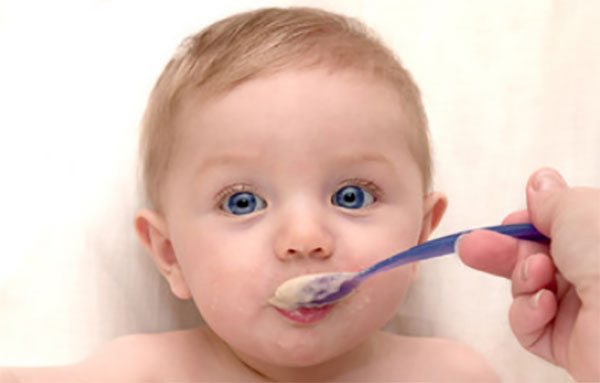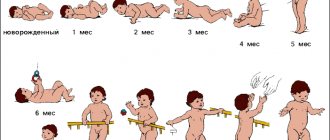Types of developmental delays
Based on the causes and nature of manifestations, there are four main types of developmental delays.
- Mental infantilism. The baby often cries, is quick-tempered and has noticeable mood swings.
- Delay of somatogenic origin. This lag is typical for children with overprotection or frequent chronic pathologies, in particular with colds.
- Neurogenic developmental delay. It is formed due to lack of attention or excessive pressure, as well as due to injuries. It is difficult for such a child to behave correctly in relation to some phenomena or other people.
- Organically - cerebral. It is observed when there are abnormalities in the baby’s body that affect the brain and the entire nervous system. This type is the most serious and much more difficult and takes longer to cure.
Causes

In fact, there may be several factors that could influence the delay in the timely development of skills. And not always what seems to be a deviation from the norm actually is. Therefore, it is very important to identify the reasons that contribute to developmental delays in order to make sure whether there is a reason for concern or not.
- Wrong training system. There are cases when the lag occurs due to the fact that no one devotes time to the baby or works with him. Naturally, such a child will develop more slowly than peers to whom parents devote a lot of time. If you start studying with a child who has been deprived of attention, then everything will return to normal quite quickly.
- Social environmental factors. Perhaps, as the baby grew older, situations arose in his environment that traumatized his psyche. It is possible that his parents took great care of him and did not allow him to be independent. Such a child at 3 years old is completely unable to perform simple actions without the help of loved ones.
- Biological reasons. It is possible that the baby was born with pathologies of brain development, which could affect his intellectual development. Such reasons may include:
- incorrect embryonic anlage of organs;
- hereditary pathologies;
- a woman taking drugs or alcohol during pregnancy;
- previous infections affecting the nervous system;
- the use of strong sedatives by the mother of the baby during pregnancy;
- abdominal injury from a fall during pregnancy;
- severe toxicosis;
- birth injuries, in particular the head, hypoxia.
How to determine the lag

Normally, a baby should be able to concentrate on an object. If this is not the case, this is an alarming sign of developmental delay.
In order for parents to be able to understand that a child is lagging behind in development a year later, they should pay attention to the manifestations of his character, actions, speech, and emotional state. In fact, you may begin to notice alarming symptoms from the first months of your baby's life.
- The child is not able to concentrate after two months of age.
- There is no reaction to sounds.
- The sucking reflex is preserved in children older than three months (the child sucks a sponge, finger or clothing).
- The baby is unable to observe moving objects.
- A toddler older than three months does not smile.
- The baby, who is four months old, does not make peculiar sounds, there is no “booming”.
- A child over three years old does not have speech, at least in some form.
- The toddler can't learn letters or read.
- A preschooler has dysgraphia and dyscalculia.
How to tell if your baby can hear?
It is important to check your baby’s hearing in the first month of life; hearing problems should be noticed as early as possible. How a child hears determines how he will develop and speak in the future. How to test a child's hearing? Very simple. To do this, you can use the method that was proposed by I.V. Kalmykova (Institute of Early Intervention, St. Petersburg). It does not require any technical equipment and is available at home.
For the examination, four plastic jars are needed, for example, from Kinder Surprise, photographic film or packaging of UPSA medicine. Three jars are filled one third full:
- the first - unshelled peas, the shaking of which creates a sound with an intensity of 70-80 dB;
- the second - buckwheat, the shaking of which creates a sound with an intensity of 50-60 dB;
- the third is a semolina, its shaking creates a sound with an intensity of 30-40 dB.
The fourth jar remains empty. The fillers in the jars should be replaced every three months.
It is advisable that the examination be carried out by two people: one gives signals from the baby’s back, and the other observes the child’s reactions.
The baby sits on a changing table or “sits” on a chair in the arms of an adult, and the adult comes into emotional contact with him. At his signal, another adult standing behind the baby shakes the jars at a distance of 20-30 cm from the right and left ears. At the same time, he has a jar of cereal in one hand, and an empty jar in the other. Hand movements must be synchronous and symmetrical. When checking the second ear, the jars are swapped. The first adult observes the child’s reactions when a sound signal is given: freezing, intensifying movements, blinking, searching for the source of the sound, etc.
Up to 4 months, the baby reacts with both the right and left ears to the sound of jars of buckwheat and peas, but does not localize their sound; The baby usually does not react to the sound of a jar of semolina. However, the examination even at this age should begin with quieter sounds (the first is a jar filled with semolina, then with buckwheat and only then with peas) in order to catch the baby’s reaction, since with repeated presentations the baby’s reaction quickly fades away (i.e. the child stops respond to sounds accessible to his hearing).
If the examination is carried out by one person, then he is positioned in front of the child in order to see changes in his reactions in response to sound stimuli. In this case, you should pay special attention to the symmetry and synchronization of the movements of both your hands.
With normal hearing, a child over 4 months of age shows reactions to the sound of all three jars (with semolina, buckwheat and peas). The child determines the direction of the sound: turns his head (or eyes) towards the jar with one or another filler. If a child clearly reacts to the sound of a jar of semolina and can localize the sound, i.e. determine its direction (with normal hearing this becomes possible from 4-5 months), then other sounds need not be presented.
In the second year of life, when the first words appear, you should check whether the child can hear them spoken in a whisper from a distance of 6 meters. To do this, you can give the child a new (unfamiliar) doll and ask: “Show me your nose, ears, hands...”. First, these phrases are pronounced in a normal voice, then in a whisper; first near the child, and then 6 meters from him.
If a baby under 4 months does not react on both the right and left to the sound of jars with buckwheat and peas (or an unclear reaction is noted: yes, then no), over 4 months of age does not react to the sound of at least one jar, for example, with semolina , or cannot find the source of the sound, and in the second year of life cannot hear individual words spoken in a whisper from 6 meters, then you need to see an audiologist (a specialist who deals with problems with hearing impairment).
It may seem to you that it is much easier to go to the children's clinic and see an ENT doctor. But, unfortunately, even an experienced otolaryngologist finds it difficult to diagnose hearing impairment in a child at an early age. Therefore, it is necessary for the children's clinic to refer you and your baby to a nearby audiology center or audiology clinic.
Treatment

Proper nutrition is an important component of successful therapy
In order to help the child, a specialist may prescribe:
- recreational activities;
- classes to correct certain skills;
- drug therapy.
General health activities include:
- correct daily routine;
- healthy eating;
- normalized physical activity.
Such children need to sleep more, and the intervals between sleep, therapeutic measures and meals should be filled with active activities.
Drug therapy is usually prescribed along with speech therapy or pedagogical classes. Also, other specialized specialists may be involved in treatment, for example, a psychiatrist, ophthalmologist, neurologist, speech therapist, speech pathologist or orthopedist.
Corrective exercises are exercises that develop proper coordination of movements, improve balance, improve walking and spatial orientation skills. Exercises focused on training reaction speed, agility and strength, as well as endurance.
Which doctor should I contact?

Some parents begin to panic when they realize that the child is behind in development; what to do in such a situation is the main question for them.
It is important not to remain idle and to seek help from a doctor in a timely manner. The doctor will be able to determine the cause of the deviation and will refer you to a specialist.
- You will see a child psychologist if your child exhibits somatic infantilism. With this pathology, the child is physically healthy; his lag is affected by a lack of attention during upbringing. This diagnosis will be relevant at the age of over four years.
- You will need a psychiatrist if there is a deviation in mental activity, antisocial behavior is noticed, and it is difficult for the baby to socialize. Such a child is most often quite aggressive, and parents are unable to cope with him. In such situations, special drug therapy cannot be avoided.
- If your baby is diagnosed with a mild form of retardation, in particular there are problems with concentration, speech delay, and memory, then a defectologist will help you.
- You will see a neurologist if the developmental delay is caused by neurological problems. As a rule, pathologies from this category are diagnosed before the age of one. Such babies cannot do without special therapy, medication and physical therapy.
Special kindergarten
If your baby is diagnosed with a developmental delay, then you should not despair right away. In addition to a possible course of treatment, you will be advised to send your child to a special program, or they will be sent to a correctional kindergarten, where most children will be able to catch up with their peers in development and can safely go to school. In such preschool institutions, small groups are recruited, and there are more teachers, nannies and speech pathologists here than in a regular kindergarten. Now you know how developmental delay can manifest itself and what to do about it. You see that such a diagnosis can be accurately established in a child as early as 2 years old. Remember that in such a situation you cannot hesitate; you need to seek qualified help in a timely manner.
From 12 to 24 months
Does the child say “mama”? By the age of one and a half years, does his speech have the first ten words or parts of them (attempts to say and repeat): mom, dad, baba, uncle, aunt, aw-aw, give? Yes - everything is fine. No - red flag.
If he speaks an “elvish” language, does he strive to switch to yours? Yes - everything is fine. No, he’s not worried about being misunderstood—a “red flag.”
Does he answer questions with nods or shakes of his head, “yes” or “no”? Yes - everything is fine. No - red flag.
If you point your finger at something distant, will he follow your hand? Yes - the norm. No (for example, you have to turn his head with your hands) is a red flag.
Does he understand your speech when you ask him to perform the simplest action (“give me the ball”, “sit down”, “follow me”)? Yes - the norm. No - red flag.
Is he interested in early children's books, especially pictures of children and animals? Yes - the norm. No - red flag.
Does he try to chew his food? Yes - everything is fine. No - red flag.
If you yawn while looking at your child, will the child yawn back? If you cough, will you cough too? Yes - everything is fine. No - red flag.
Does he have a healthy wariness towards strangers (the period of “fear of strangers” when the child hides behind his mother’s back)? Yes - everything is fine. No (goes to any adult) - “red flag”.
Do you feel like it's hard to teach him new things because he doesn't listen to you or look at you? Yes - a red flag.
Does he show concern from wet underpants? Does he come up to you when he peed himself or crap himself, does he try to show it? Yes is the norm, no is a “red flag”.
Can he show his nose, ears, arms, legs? And you? What about the bear? Yes - the norm. No - red flag.
Does he recognize you and your family members in recent photographs? Yes - the norm. No - red flag.
Have you noticed a loss of any skills in your child between one and a half to two and a half years? Yes - a red flag.
Do you feel that as your child approaches two years of age, he begins to move away from you and prefer to play on his own? Yes - a red flag.
Does he have an overly strong desire for order and cleanliness (for example, is he afraid to drop even a piece of food or cries and demands to wash his hand when it comes into contact with sand)? Yes - a red flag.
How does he react to your anger in case of wrongdoing or to any frustration? Does this reaction look like a healthy one, or, for example, does he self-harm (bites himself, hits himself). Or doesn't react at all? A self-harm response or lack of response is a “red flag.” A healthy child gets upset, may get scared, cry, but will not harm himself. And, of course, he will not ignore your reaction.

Photo source: pixabay.com











